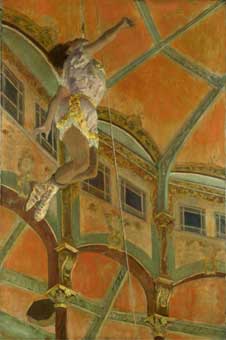Edgar Hilaire-Germain Degas thought every plein-air painter in Paris should be shot dead. He disliked the way they obstructed the city’s boulevards and positively hated the way in which they misunderstood the very nature of the artist’s vocation – which, as far as he was concerned, was not merely to copy the visible world, but to transform it through the alchemy of memory and imagination. Degas took a similar line on art education. He once dreamed of founding an art school in a house built on six floors. The model and beginners would be placed together at the top, under the eaves, but as each novice progressed with his studies he would be gradually removed from the life-class, one floor at a time. The mature artist – Degas himself, by implication – would need only very occasionally to climb all six flights of stairs to gaze at his subject. Memory would do the rest.
Was Degas alluding to that same imaginary art school when he signed his name on the second step of the spiral staircase in the foreground of The Rehearsal, of circa 1873-4, a depiction of young ballerinas backstage at the Paris Opera, stretching, flexing and wearily at rest? He obviously thought carefully about the placement of that apparently insouciant, scrawled signature. It insinuates that while he did indeed witness this scene, he did not stay long, was only passing through. The real work took place elsewhere, when the painter was in his studio, alone with his mental snapshot album of fragmentary recollections: a wide expanse of wooden floor, shadowed by the human form in movement; dancers, a troupe of gauzy anonymes, lost in concentration; a few bright mosaics of light and blurred colour, filtering through tall windows; a thoughtful dancing master in a vest of...

Review of "Degas, Sickert and Toulouse-Lautrec" at Tate Britain
09-10-2005

